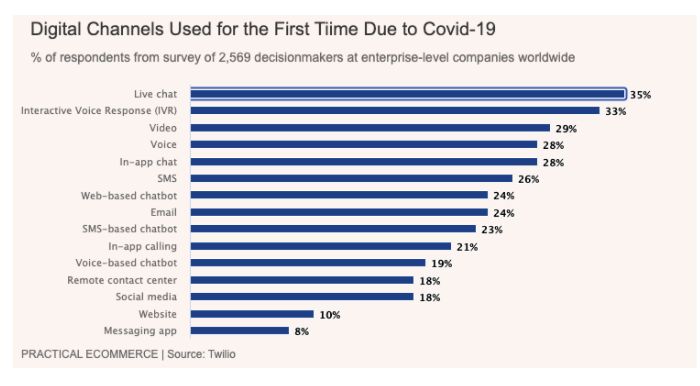Key Trends To Watch Out For The Digital First Holiday Season 2020
This holiday season, 30% of global retail sales will be through digital channels. Are you ready to make the most of it?
The evident effects of COVID-19 on consumer behavior have pushed retail models to integrate more online channels. In the new normal, most customers are engaging with three to five channels during buying journeys. On top of that, reports suggest that the paradigm shift towards online shopping is a permanent one that will remain even after stores reopen. As a result, this year’s holiday season is going to be one of the most challenging for retailers. And the road to meet new customer expectations is via digitalization.
Retailers need to elevate digital experiences across channels with consistent information dissemination, on-demand customer support, and timely issue resolution. Significant scaling and refining of digitalization approaches throughout their value chain can remodel operations and stream revenue. By blurring the divide between online and physical retail with advanced tools and deliberate strategy, retailers can revamp their practices to navigate the upcoming holiday season successfully.
Let us explore short-term and long-term strategies that retailers can follow.
Short-term action plan
You can implement certain strategic moves in a short span. These immediate actions are responsive in nature and can help recover from the pandemic-infused shock.
Action #1
The first step is ensuring seamless retail operations like pre-pandemic times. Everything must be in place for seamless operations, from collaboration tools and API integrations to employee timesheets, master data management, and dashboard visibility. Going completely digital means sourcing interim communication and collaboration tools to enable a remote workforce while ensuring security and network support. The key is having an IT architecture that supports “self-healing” end-points and promotes quick and more efficient escalation of key learnings and insights. This way business-critical operations such as experience design, customer support, and go-to-market discussions can be conducted without any gaps, risks, or misalignment.
Action #2
The second step is managing offline channels with the online ones by balancing store opening times and employee shifts. If handled carefully, stores can be instrumental for last-mile deliveries and convenient pickups, acting like contactless fulfillment centers. Personnel shifts can be prioritized by focusing on areas of high demand. Also, the number of shifts per employee must be regulated for enhanced sanitization and disinfection. Additional measures may include having one-way traffic aisles, mandatory hand sanitizer at the entrance, plexiglass shields at cash registers, stringent administration of trial rooms and testers, social distance in checkout queues, touchless payments, and thorough cleaning of racks, shelves, and shopping carts.
Action #3
Consistent engagement with different stakeholders is another crucial step. In uncertain times, digital channels can be a silver lining for communicating with customers/employees/partners and maintaining relations. Traditional methods of communicating vital information or launching products or running campaigns have to be digitized. Be it the brand website, internal portals, vendor partnership channels, social media, mobile applications, conversational AI — the more you optimize channel management, the better presence you’ll create. The aim is to connect with customers and partners and maximize sales via digital platforms. This will help brands reach audiences across multiple placements with targeted marketing and focused offerings at low costs.

Action #4
One of the most drastic setbacks created by the pandemic was the lack of visibility across the value chains. Without a centralized system that interconnects different departments, teams, and units, retailers can quickly lose track of what is happening to varying stages of the value chain. Without shared knowledge, there is little trust and lots of scope of manual errors, data inaccuracies, and redundancies. Therefore, a single source of truth can establish a foundation of trust and transparency. When you digitize your internal and external operations, a massive amount of data flows through the organization. Only with a consolidated view provided by a data management tool can you skim the data and leverage it to derive actionable insights.
Long-term action plan
Apart from the short-term actions, retailers must also look at the bigger picture and plan. Long-term planning can help them prepare for future uncertainties with agility and scalability. However, these action items take time to strategize and execute and need to be aligned with the company’s vision and mission.
Action #1
The journey to a completely digital ecosystem begins from within the organization. To create a digital landscape where most processes are (or can be) carried out via online mediums, you must first reform the workplace and workforce. You can develop a strategy that includes collaboration applications, security controls, bring-your-own-device (BYOD) programs, and network support. With such an ecosystem, you can best prepare for future uncertainties and ensure that every employee down to frontline workers are onboard. It will also reduce the talent gap and downtime.
Action #2
Adding to the first action plan, retailers should also identify alternative digital technologies to empower employees and automate tasks. You can streamline internal processes that foster shared data, collaboration, and knowledge retention. With a chatbot that can automate HR processes like employee onboarding, policy reformations, and consistent employee engagement, you can significantly iron out operational creases. You can integrate advanced, employee-centric technologies like whiteboards, IoT sensors, digital footprint analytics, etc. Frictionless retail, which operates under a cashier-less grab-and-go format and eliminates checkout lines, can also reduce manual task lists.
Action #3
Another long-term action item is expanding reach to all digital channels and developing corresponding product extensions. Your offerings should be available online. Additionally, reports suggest that brands that adapt to this new normal with innovative ideas like curbside, inside, and drive-through pickups can witness a 90% increase in digital sales over the previous holiday season. It is, therefore, advisable to enable digital business models that increase resilience and growth. Retailers can also reassess and strategize, whether to relocate, remodel, or close their brick-and-mortar locations with agile and proactive approaches.
Action #4
Improving data literacy and adopting advanced data management and analytics tools is probably one of the most important long-term business steps. Every retailer holds valuable consumption data that can be commoditized to create additional revenue streams. By investing in a cutting-edge analytics tool, retailers can collect, process, and analyze data regarding audience segmentation, offline/online footfalls, demand peaks, customer feedback, local demographics, and behavioral metrics. It can then be used for better inventory visibility, targeted marketing, product design, order orchestration, logistical routing, etc.
The Conclusion
Digital is inevitable this holiday season. Retailers across the globe are striving to digitalize processes and touch points as much as possible. But the competitive edge can be gained only if you segregate between the short-term and long-term goals and act accordingly.
As the holiday season unfolds, be ready to create data-driven and process-oriented playbooks that elevate customer and employee experience alike. Reconfigure mode of operations with carefully planned short-term and long-term strategies to win in a highly uncertain season.
Read my full article originally published at CustomerThink.




Comments
Post a Comment